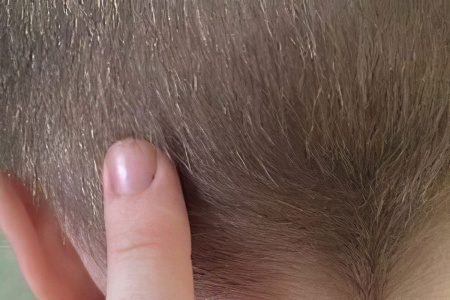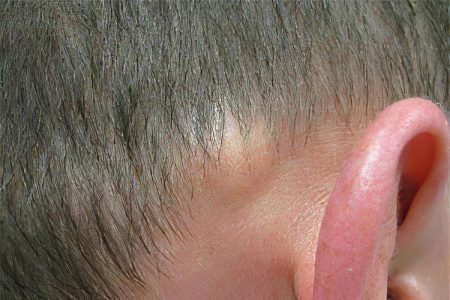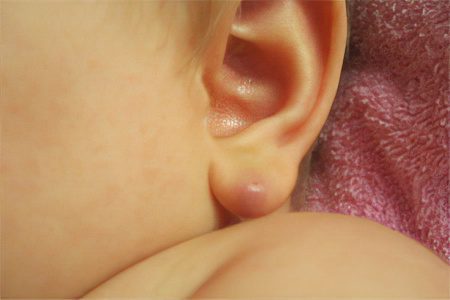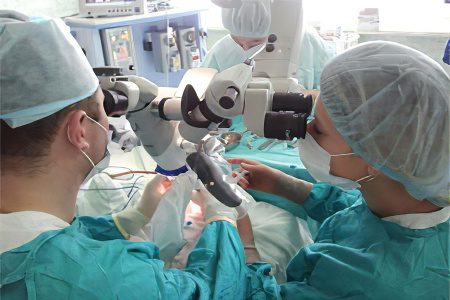Contents

There are a large number of sebaceous glands around the auricle, so there is a high probability of atheroma formation in this area. This is a slowly growing subcutaneous fatty tumor, characterized by a benign character. According to medical statistics, atheroma occupies only about 0,2% of the total number of neoplasms of the soft tissues of the head. The most common is atheroma of the earlobe, since there is a fatty layer there, but the lobe does not have cartilaginous tissue.
Atheroma code according to ICD-10: L72.1. This is a trichodermal cyst.
Factors in the development of atheroma near the auricle

The main reason for the formation of atheroma is the blockage of the excretory duct of the sebaceous gland. This condition is caused by a hormonal imbalance or fat metabolism disorder. Hormonal failure provokes excessive accumulation of the secretion of the sebaceous glands (glandulae sebacea).
Other causes of atheroma:
Seborrhea;
Head trauma with scarring of the skin near the ear;
earlobe piercing;
Diabetes;
increased sweating;
Hypothermia or overheating as a result of solar insolation;
Violation of hygiene rules.
As a result of the above reasons, the duct of the sebaceous gland narrows, the composition of its secret changes, it becomes more dense. The cavity of the sebaceous gland cyst increases, it accumulates fat, keratinized particles of the epithelium, cholesterol crystals. This leads to the fact that atheroma steadily increases and becomes noticeable.
Signs of atheroma near the ear

At the beginning of the development of pathology, when the sebaceous secret thickens, but the exit from the gland is not yet clogged, subcutaneous fat can be released outward. Its increasing viscosity leads to the final blockage of the duct of the sebaceous gland. The process goes quite slowly, not accompanied by pain or other unpleasant manifestations.
Symptoms of the formed atheroma:
Round contour, small size;
On palpation, an elastic formation of a dense consistency is determined, not soldered to the skin;
Inside the atheroma capsule there is a mushy secret (detritus);
Atheroma can become inflamed, suppurate;
The exit from the sebaceous gland can be visualized as a dark dot, with inflammation of the atheroma, the exit is determined as a white bulge;
Partial adhesion of atheroma to the skin may prevent the skin from gathering into a fold;
With an increase in atheroma, itching and burning may appear;
With inflammation of the tumor, a subcutaneous abscess develops with the appearance of pain, an increase in skin temperature in the area of suppuration, hyperemia of the epidermis;
With spontaneous opening of atheroma, part of the pus is released, but the cyst remains unchanged and a recurrence of the tumor appears;
Accession of a secondary infection is manifested by symptoms of intoxication – weakness, headache, fatigue, hyperthermia, nausea.
In many cases, atheroma is determined quite by accident – when washing or washing your hair. If a lump resembling a ball appears in the auricle area, you should immediately show the child to a doctor – a surgeon or a dermatologist.
Pathogenesis of atheroma of the ear in children

A sebaceous cyst in a child may be congenital. It is always benign, according to the diagnostic standard, it is required to differentiate atheroma from lipoma, dermoid cyst, enlarged lymph node, furunculosis.
If atheroma in a child is not congenital, its appearance can be triggered by increased production of sebaceous gland secretion at 5-6 years of age and further – during puberty. Less commonly, the cause of the formation of atheroma in a child is an injury to the epidermis with an incorrect haircut or ignoring the rules of hygiene.
Behind the ear atheroma in children often does not manifest itself in any way, the child does not feel any pain or discomfort. Characteristic symptoms appear with inflammation and abscess formation. The abscess can be very large. If it opens, the atheroma capsule remains and provokes relapses. Only surgical intervention will help to get rid of it radically.
Atheroma of small size in children under 3-4 years of age is not removed, the tumor is monitored in dynamics. After 4 years, the atheroma capsule is husked under general anesthesia. At the age of 7 years and older, local anesthesia is used. Surgical intervention for the removal of atheroma in children lasts 30-40 minutes, it is considered a simple manipulation. This operation will avoid such complications as infection of the soft tissues of the head, the appearance of phlegmon.
There is a modern method for the destruction of atheroma – its “evaporation” with a radio wave knife, which does not leave marks on the child’s skin. Such treatment is very effective, as it eliminates the risk of recurrence and does not lead to the formation of a scar.
Behind the ear atheroma

Such a neoplasm appears very rarely, because the tissue behind the ear contains almost no fat layer. Such a cyst is differentiated from atheroma of the salivary gland, using, in addition to visual examination, X-ray examination, ultrasound of the lymph nodes, and computed tomography. If there are no signs of inflammation, the behind-the-ear atheroma is excised in the “cold period”, and the extracted material is sent for histological analysis to confirm the diagnosis.
It is important to distinguish atheroma from lipoma in a timely manner, which is quite difficult, since the symptoms of the diseases are similar. Both lipoma and atheroma of the behind-the-ear space have a dense texture, they are painless. However, on the surface of the atheroma, it is sometimes possible to distinguish a dark dot at the site of the exit of the gland duct to the outside. With inflammation of the behind-the-ear atheroma, pain appears, the temperature of the skin in the area of suppuration rises.
The transformation of atheroma into an abscess or phlegmon leads to symptoms of intoxication, and these are:
Hyperthermia;
Headache;
Weakness, increased fatigue;
Nausea.
With spontaneous opening of behind-the-ear atheroma, pus spreads through the subcutaneous tissue, spilling into the ear canal and cartilaginous tissue of the auricle. There is intoxication, there is a risk of developing sepsis.
Removal of behind-the-ear atheroma is complicated by the risk of damage to the behind-the-ear lymph nodes and blood vessels.
The operation is painless and fast if modern technologies are used:
laser surgery;
radio wave surgery.
After their use, there are no scars, there are no relapses.
Atheroma on the ear lobe

The appearance of a benign tumor on the earlobe is due to the fact that in this area there is subcutaneous fatty tissue, which is absent in areas with cartilaginous tissue. Most often, the occurrence of atheroma is provoked by damage to the tissues of the lobe during their injury, puncture. This organ is not hormonally dependent, therefore, hormonal imbalance and the onset of puberty rarely become factors provoking the appearance of atheroma.
Other causes of atheroma on the earlobe:
Infection of tissues during puncture of the earlobe;
Granulation of the puncture site;
Injury of the earlobe with a bruise, laceration, formation of a keloid scar;
Наследственность.
Symptoms of atheroma:
Sealing up to 40-50 mm in size;
Absence of pain and discomfort;
Inflammation in the process of wearing earrings or clips against the background of infection, the formation of an abscess;
Re-accumulation of pus after spontaneous opening of the formation due to the fact that the atheroma capsule remained in place.
It is desirable to remove atheroma on the earlobe when it is small. In this case, the operation takes place quickly, without consequences, with the formation of an imperceptible scar. Removal of atheroma in the stage of a large cyst leads to an increased risk of developing an abscess.
Diagnosis behind the ear atheroma

It is important to timely distinguish the atheroma of the behind-the-ear space from such formations of the subcutaneous tissue, such as:
The initial stage of lymphangioma;
Lipoma;
fibroma;
Papilloma;
Chondroma;
Behind the ear dermoid cyst;
Lymphadenitis;
Subcutaneous furuncle.
Main diagnostic methods:
Inspection and palpation of the formation, regional lymph nodes by a dermatologist, dermato-oncologist;
X-ray, CT skull;
Otoscopy (study of the features of the internal auditory canal);
Ultrasound of the lymph nodes;
Cytology of swabs from the ear canal;
Biopsy and histology of removed tissues after surgery.
Laboratory diagnostic methods:
General and biochemical blood test;
Urinalysis, determination of sugar level;
Blood test for RW.
The risk of malignancy of the neoplasm must be completely excluded. Although atheroma is considered a benign tumor, it must be distinguished from similar conditions that have a risk of malignancy.
Treatment of atheroma on the earlobe

Removal of atheroma involves only a surgical method of treatment. Other methods are not able to completely get rid of the tumor. Even opening the cyst and removing the sebaceous secret that has accumulated in it will not solve the problem.
Methods of surgical intervention:
Cyst enucleation by the traditional method – the cyst is opened under local anesthesia, its contents are displayed on a sterile napkin, the atheroma capsule is excised to healthy tissue;
Laser surgery – used to remove small atheromas without signs of inflammation;
Radio wave surgery – does not require long-term rehabilitation and suturing, the scar heals in a week.
After removal of atheroma by any method, the obtained tissues are subjected to histological examination.
Treatment of behind-the-ear atheroma

A tumor of such localization can be cured exclusively by surgery. Its removal requires preliminary preparation, since the behind-the-ear space is rich in blood vessels, there are lymph nodes there. Careful diagnosis will eliminate the risk of relapses and complications.
Methods for removing atheroma behind the ear:
The traditional method using a scalpel is used to excise inflamed tumors that have purulent contents. The cyst is opened, drained, and after the inflammatory process subsides, the capsule is excised to a healthy tissue;
Laser method – small atheromas without signs of inflammation are removed, and the blood vessels are coagulated at the same time, the suture heals in 5-7 days;
Evaporation of the tumor and cyst cavity using the radio wave method is a gentle method that does not have complications and does not leave a cosmetic defect.
The appearance of atheroma in a child behind the ear or on his lobe is a reason to see a doctor. After a thorough diagnosis, the only possible method of treatment is used – radical removal of the tumor along with the cyst shell.









